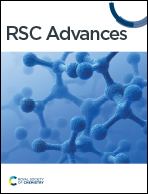Highly sensitive amperometric sensors based on laccase-mimetic nanozymes for the detection of dopamine†
Abstract
The current research presents novel sensors based on laccase-like mimetics for the detection of dopamine (DA). The synthesized laccase-like nanozymes (nAuCu, nPtCu, nCuMnCo, and nCoCuCe) were prepared by a simple hydrothermal method and exhibited an attractive catalytic activity toward DA. The developed amperometric sensors based on laccase nanozymes (nAuCu and nPtCu) are more stable, selective, and revealed a higher sensitivity (6.5-fold than the biosensor based on the natural fungal laccase from Trametes zonata). The amperometric sensors were obtained by modification of the glassy carbon electrodes (GCEs) with AuPt nanoparticles. Functionalization of the electrode surface by AuPt NPs resulted in increased catalytic activity of the laccase-like layer and higher sensitivity. Among studied configurations, the sensor containing nAuCu and nAuPt possesses a wide linear range for dopamine detection (10–170 μM), the lowest limit of detection (20 nM), and the highest sensitivity (10 650 ± 8.3 A M−1 m−2) at a low applied potential (+0.2 V versus Ag/AgCl). The proposed simple and cost-effective sensor electrode was used for the determination of DA in pharmaceuticals.



 Please wait while we load your content...
Please wait while we load your content...